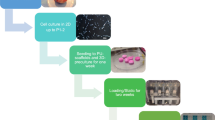Abstract
Purpose
The combination of scaffolds and biological factors may enhance articular cartilage repair. Little is known regarding the activation and subsequent growth factor release of platelet-rich plasma (PRP) in contact with biosynthetic scaffolds. The purpose of this study was i) to identify whether the addition of thrombin was required to activate PRP in the presence of a collagen osteochondral scaffold and ii) to compare the activity of PRP when applied to both collagen- and polylactide-based osteochondral scaffolds.
Methods
Equal combined volumes of test substances were used (n = 3): 500 μl PRP alone or on scaffolds; 375 μl PRP + 125 μl autologous thrombin on scaffolds; 455 μl PRP + 45 μl bovine thrombin on scaffolds. Scaffolds and/or PRP were cultured in vitro in DMEM/F12 medium for 10 days. TGF-β1, PDGF-AB and bFGF were measured using ELISA.
Results
A similar cumulative release profile in all growth factors was found over the 10-day period i.e. a burst release and further physiological prolonged release. A significantly higher release of PDGF-AB was seen in the PRP + collagen scaffold groups at all time points, compared to scaffold + PRP + thrombins (P < 0.001). A significantly increased cumulative volume of PDGF-AB was released from the collagen scaffold compared to the polylactide scaffold (P < 0.001).
Conclusion
This study shows that polylactide and particularly collagen osteochondral scaffolds activate PRP in vitro. If PRP is combined with these scaffolds clinically, no exogenous activation with thrombin is required to achieve growth factor release, which may be of benefit for articular cartilage repair applications.


Similar content being viewed by others
References
Akeda K, An HS, Okuma M et al (2006) Platelet-rich plasma stimulates porcine articular chondrocyte proliferation and matrix biosynthesis. Osteoarthritis Cartilage 14:1272–1280
Alsousou J, Thompson M, Hulley P et al (2009) The biology of platelet-rich plasma and its application in trauma and orthopaedic surgery: a review of the literature. J Bone Joint Surg Br 91:987–996
Brehm W, Aklin B, Yamashita T et al (2006) Repair of superficial osteochondral defects with an autologous scaffold-free cartilage construct in a caprine model: implantation method and short-term results. Osteoarthritis Cartilage 14:1214–1226
Ferrari M, Zia S, Valbonesi M et al (1987) A new technique for hemodilution, preparation of autologous platelet-rich plasma and intraoperative blood salvage in cardiac surgery. Int J Artif Organs 10:47–50
Fufa D, Shealy B, Jacobson M et al (2008) Activation of platelet-rich plasma using soluble type I collagen. J Oral Maxillofac Surg 66:684–690
Gandhi NS, Mancera RL (2008) The structure of glycosaminoglycans and their interactions with proteins. Chem Biol Drug Des 72:455–482
Getgood A, Brooks R, Fortier L, Rushton N (2009) Articular cartilage tissue engineering: today’s research, tomorrow’s practice? J Bone Joint Surg Br 91:565–576
Gobbi A, Bathan L (2009) Biological approaches for cartilage repair. J Knee Surg 22:36–44
Han B, Woodell-May J, Ponticiello M et al (2009) The effect of thrombin activation of platelet-rich plasma on demineralized bone matrix osteoinductivity. J Bone Joint Surg Am 91:1459–1470
Hunziker EB (2002) Articular cartilage repair: basic science and clinical progress. A review of the current status and prospects. Osteoarthritis Cartilage 10:432–463
Kerker JT, Leo AJ, Sgaglione NA (2008) Cartilage repair: synthetics and scaffolds: basic science, surgical techniques, and clinical outcomes. Sports Med Arthrosc 16:208–216
Kevy SV, Jacobson MS (2004) Comparison of methods for point of care preparation of autologous platelet gel. J Extra Corpor Technol 36:28–35
Kon E, Buda R, Filardo G et al (2010) Platelet-rich plasma: intra-articular knee injections produced favorable results on degenerative cartilage lesions. Knee Surg Sports Traumatol Arthrosc 18:472–479
McCarrel T, Fortier L (2009) Temporal growth factor release from platelet-rich plasma, trehalose lyophilized platelets, and bone marrow aspirate and their effect on tendon and ligament gene expression. J Orthop Res 27(8):1033–1042
Numakura M, Kusakabe N, Ishige K et al (2010) Preparation of chondroitin sulfate libraries containing disulfated disaccharide units and inhibition of thrombin by these chondroitin sulfates. Glycoconj J 27:479–489
Ofosu FA, Crean S, Reynolds MW (2009) A safety review of topical bovine thrombin-induced generation of antibodies to bovine proteins. Clin Ther 31:679–691
Roussy Y, Bertrand Duchesne MP, Gagnon G (2007) Activation of human platelet-rich plasmas: effect on growth factors release, cell division and in vivo bone formation. Clin Oral Implants Res 18:639–648
Sanchez M, Anitua E, Azofra J et al (2008) Intra-articular injection of an autologous preparation rich in growth factors for the treatment of knee OA: a retrospective cohort study. Clin Exp Rheumatol 26:910–913
Sanchez M, Azofra J, Anitua E et al (2003) Plasma rich in growth factors to treat an articular cartilage avulsion: a case report. Med Sci Sports Exerc 35:1648–1652
Trippel SB (1995) Growth-Factor Actions on Articular-Cartilage. J Rheumatol 22:129–132
Acknowledgments
The authors would like to acknowledge grant funding support from the UK Technology Strategy Board in collaboration with Tigenix Ltd, formerly Orthomimetics Ltd, Cambridge, UK.
Conflict of interest
This work was supported by the UK Technology Strategy Board in collaboration with Tigenix Ltd, formerly Orthomimetics Ltd. Two of the authors (AG, NR) receive consultancy fees from Tigenix Ltd. LF receives institutional support from Harvest Technologies Ltd.
Author information
Authors and Affiliations
Corresponding author
Rights and permissions
About this article
Cite this article
Getgood, A., Henson, F., Brooks, R. et al. Platelet-rich plasma activation in combination with biphasic osteochondral scaffolds–conditions for maximal growth factor production. Knee Surg Sports Traumatol Arthrosc 19, 1942–1947 (2011). https://doi.org/10.1007/s00167-011-1456-6
Received:
Accepted:
Published:
Issue Date:
DOI: https://doi.org/10.1007/s00167-011-1456-6




